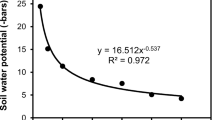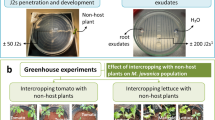Abstract
Root-knot nematodes (Meloidogyne spp.) can parasitize and reduce yields of nearly all agricultural crops. Although migration studies focus on the model species, M. incognita, there is little information about M. enterolobii, which has been a major threat for guava in Brazil. The vertical migration of second-stage juveniles (J2) of M. enterolobii and M. incognita was evaluated to determine the effect of good host and nonhost plants on nematode motility. Fourteen-cm long soil columns were constructed of PCV rings with Styrofoam cups containing a 4-week-old tomato or marigold (Tagetes patula) seedlings as plant stimuli; host-free cups were used as nontreated control. After inoculating 1000 freshly-hatched J2, the columns were placed in environmental chamber sets at 20 °C. The columns were disassembled at 3, 6, and 9 days after inoculation (DAI). The experiment was completely randomized block with four replicates. J2 were extracted from each ring and cup, while tomato and marigold roots were stained to observe J2 that penetrated roots. Data were subjected to repeated-measure MANOVA and chi-square test to compare J2 distribution along the columns. The migrations under tomato and marigold stimuli were comparable to those under host-free columns. Although both species migrated over 13 cm, M. enterolobii was more mobile than M. incognita. Juveniles of M. enterolobii infected tomato roots as early as 3 DAI, whereas marigold delayed nematode penetration. Our results show that two species of root-knot nematodes behave differently within the soil, and under the same conditions J2 of M. enterolobii migrate faster than M. incognita.




Similar content being viewed by others
References
Andaló, V., Moreira, G. F., & Moino Junior, A. (2014). Heterorhabditis amazonensis RSC5 (Rhabditida: Heterorhabditidae) movement and host recognition. Revista Colombiana de Entomologia, 40(1), 91–97.
Bilgrami, A. L., & Gaugler, R. (2004). Feeding behavior. In R. Gaugler & A. L. Bilgrami (Eds.), Nematode behaviour (pp. 63–90). Wallingford: CAB International.
Buena, A. P., Díez-Rojo, M. A., López-Pérez, J. A., Robertson, L., Escuer, M., & Bello, A. (2008). Screening of Tagetes patula L. on different populations of Meloidogyne. Crop Protection, 27, 96–100.
Byrd Jr., D. W., Kirkpatrick, T., & Barker, K. R. (1983). An improved technique for clearing and staining plant tissues for detection of nematodes. Journal of Nematology, 15(1), 142–143.
Carneiro, R. M. D. G., Hidalgo-Díaz, L., Martins, I., Silva, K. F. A. S., Sousa, M. G., & Tigano, M. S. (2011). Effect of nematophagous fungi on reproduction of Meloidogyne enterolobii on guava (Psidium guajava) plants. Nematology, 13(6), 721–728.
Castro, C. E., Belser, N. O., McKinney, H. E., & Thomason, I. J. (1989). Quantitative bioassay for chemotaxis with plant parasitic nematodes. Journal of Chemical Ecology, 15(4), 1297–1309.
Correia, E. C. S. S., Silva, N., Costas, M. G. S., & Wilcken, S. R. S. (2015). Reproduction of Meloidogyne enterolobii in lettuce cultivars of the American group. Horticultura Brasileira, 33(2), 147–150.
Dalzell, J. J., Kerr, R., Corbett, M. D., Fleming, C. C., & Maule, A. G. (2011). Novel bioassays to examine the host-finding ability of plant-parasitic nematodes. Nematology, 13(2), 211–220.
Davis, R. F., Earl, H. J., & Timper, P. (2014). Effect of simultaneous water deficit stress and Meloidogyne incognita infection on cotton yield and fiber quality. Journal of Nematology, 46(2), 108–118.
Dutta, T. K., Powers, S. J., Gaur, H. S., Birkett, M., & Curtis, R. H. C. (2012). Effect of small lipophilic molecules in tomato and rice root exudates on the behaviour of Meloidogyne incognita and M. graminicola. Nematology, 14(3), 309–320.
Dutta, T. K., Powers, S. J., Kerry, B. R., Gaur, H. S., & Curtis, R. H. C. (2011). Comparison of host recognition, invasion, development and reproduction of Meloidogyne graminicola and M. incognita on rice and tomato. Nematology, 13(5), 509–520.
Elling, A. A. (2013). Major emerging problems with minor Meloidogyne species. Phytopathology, 103(11), 1092–1102.
Francilino, A. H., Pedrosa, E. M. R., Silva, E. F. F., Rolim, M. M., Cardoso, M. S. O., & Maranhão, S. R. V. L. (2017). Efeito do fluxo de água, isca vegetal e volume de poros do solo na mobilidade de Pratylenchus coffeae. Nematropica, 47(1), 63–73.
Fujimoto, T., Hasegawa, S., Otobe, K., & Mizukubo, T. (2010). The effect of soil water flow and soil properties on the motility of second-stage juveniles of the root-knot nematode (Meloidogyne incognita). Soil Biology & Biochemistry, 42, 1065–1072.
Gallardo, J. Á. M., Valdés, T. D., Ruvalcaba, L. P., Molar, R. A., Torres, J. V., & Fasio, J. A. C. (2015). Nematodos fitoparasitos y su relación con factores edáficos de papaya em Colima, México. Révista Mexicana de Ciências Agrícolas, 6(1), 251–257.
Guimarães, L. M. P., Moura, R. M., & Pedrosa, E. M. R. (2003). Parasitismo de Meloidogyne mayaguensis em diferentes espécies botânicas. Nematologia Brasileira, 27(2), 139–147.
Hussey, R. S., & Barker, K. R. (1973). A comparison of methods colleting inocula of Meloidogyne spp. including a new technique. Plant Disease Report, 57, 1025–1028.
Jenkins, W. R. (1964). A rapid centrifugal-flotation technique for separating nematodes from soil. Plant Disease Report, 48(9), 692.
Moens, M., Perry, R. N., & Starr, J. L. (2009). Meloidogyne species – A diverse group of novel and important plant parasites. In R. N. Perry, M. Moens, & J. L. Starr (Eds.), Root-knot nematodes (pp. 1–17). Wallingford: CAB International.
Moreira, F. J. C., Araújo, B. A., Lopes, F. G. N., Sousa, A. A. L., Sousa, A. E. C., Andrade, L. B. S., et al. (2018). Assessment of the Tephrosia toxicaria essential oil on hatching and mortality of eggs and second-stage juveniles (J2) root-knot nematode (Meloidogyne enterolobii and M. javanica). Australian Journal of Crop Science, 12(12), 1829–1836.
Nježić, B., Sutter, N., & Moens, M. (2014). Interaction of Tagetes patula cv. Single gold with the life cycle of the plant-parasitic nematodes Meloidogyne chitwoodi and Pratylenchus penetrans. Russian Journal of Nematology, 22(2), 101–108.
Pinkerton, J. N., Mojtahedi, H., Santo, G. S., & O’Bannon, J. H. (1987). Vertical migration of Meloidogyne chitwoodi and M. hapla under controlled temperature. Journal of Nematology, 19(2), 152–157.
Pline, M., & Dusenbery, D. (1987). Responses of plant-parasitic nematode Meloidogyne incognita to carbon dioxide determined by video camera-computer tracking. Journal of Chemical Ecology, 13(4), 873–888.
Prot, J. (1976). Amplitude et cinétique des migrations du nématode Meloidogyne javanica sous l’influence d’um plant de tomate. Cahiers – ORSTOM. Série Biologie, 6(3), 157–166.
Prot, J. (1978). Horizontal migrations of second-stage juveniles of Meloidogyne javanica in sand in concentration gradients of salts and in a moisture gradient. Revue de Nématologie, 2(1), 17–21.
Prot, J. (1980). Migration of plant-parasitic nematodes towards plant roots. Revue de Nématologie, 3(2), 305–318.
Prot, J., & van Gundy, S. D. (1981a). Influence of photoperiod and temperature on migrations of Meloidgoyne juveniles. Journal of Nematology, 13(2), 217–220.
Prot, J., & van Gundy, S. D. (1981b). Effect of soil texture and the clay component on migration of Meloidogyne incognita second-stage juveniles. Journal of Nematology, 13(2), 213–217.
Pudasaini, M. P., Viaene, N., & Moens, M. (2007). The influence of host and temperature on the vertical migration of Pratylenchus penetrans. Nematology, 9(3), 437–447.
Rashidifard, M., Fourie, H., Véronneau, P., Marais, M., Daneel, M. S., & Mimee, B. (2018). Genetic diversity and phylogeny of South African Meloidogyne populations using genotyping by sequencing. Scientific Reports, 8, 13816.
Reynolds, A. M., Dutta, T. K., Curtis, R. H. C., Powers, S. J., Gaur, H. S., & Kerry, B. R. (2011). Chemotaxis can take plant-parasitic nematodes to the source of a chemo-attractant via the shortest possible routes. Journal of the Royal Society Interface, 8(57), 568–577.
Rocha, F. S., Campos, V. P., Fernandes, M. F. G., & Muniz, M. F. S. (2016). Migration and reproduction of Meloidogyne incognita in two soil textures. Nematropica, 46(2), 162–171.
Rodríguez-Kábana, R., & Pope, M. H. (1981). A simple incubation method for the extraction of nematodes from soil. Nematropica, 11(2), 175–186.
RStudio Team. (2015). RStudio: Integrated development for R. Boston: RStudio, Inc. http://www.rstudio.com/. Accessed 12 March 2019.
Spence, K. O., Lewis, E. E., & Perry, R. N. (2008). Host-finding and invasion by entomopathogenic and plant-parasitic nematodes: Evaluating the ability of laboratory bioassays to predict field results. Journal of Nematology, 40(2), 95–98.
van Gundy, S. D. (1985). Ecology of Meloidogyne spp. - emphases on environmental factors affecting survival and pathogenicity. In J. N. Sasser & C. C. Carter (Eds.), An advanced treatise on Meloidogyne (Vol. 1, pp. 177–182). Raleigh: North Carolina University Graphics.
Wallace, H. R. (1958a). Movement of eelworms. I. The influence of pore size and moisture content of the soil on the migration of larvae of the beet eelworm, Heterodera schachtii Schmidt. Annals of Applied Biology, 46(1), 74–85.
Wallace, H. R. (1958b). Movement of eelworms. II. A comparative study of the movement in soil of Heterodera schachtii Schmidt and of Ditylenchus dipsaci (Kuhn) Filipjev. Annals of Applied Biology, 46(1), 86–94.
Wallace, H. R. (1966). Factors influencing the infectivity of plant parasitic nematodes. Proceedings of the Royal Society B, 164, 592–614.
Acknowledgments
This research was supported by a Scholarship Grant (PDSE - 88881.135122/2016-01) from the Brazilian Federal Agency for Support and Evaluation of Graduate Education (CAPES). The authors thank the staff from the Department of Entomology and Nematology from the University of Florida, Gainesville FL, for the technical support.
Author information
Authors and Affiliations
Corresponding author
Ethics declarations
Conflict of interest
The authors declare that they have no conflict of interest.
Research involving human participants and/or animal
The research did not involve human participant or animals.
Informed consent
N/A
Rights and permissions
About this article
Cite this article
dos Santos Oliveira, A.K., Pedrosa, E.M.R., Dickson, D.W. et al. Migration and penetration of Meloidogyne enterolobii and M. incognita in soil columns with tomato and marigold. Eur J Plant Pathol 158, 591–598 (2020). https://doi.org/10.1007/s10658-019-01889-7
Accepted:
Published:
Issue Date:
DOI: https://doi.org/10.1007/s10658-019-01889-7




